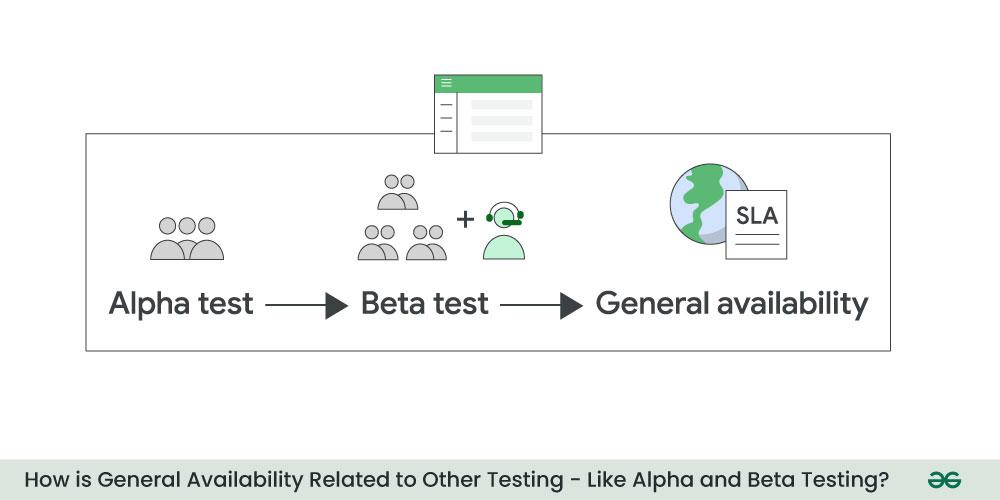General Availability | Introduction, Importance and Examples
Last Updated :
23 Jul, 2025
General availability is the release of a product to the wider public. It is commonly referred to as GA and signifies when a product is considered ready for use and is made available, to the public. This significant milestone necessitates an understanding of product management including definitions, significance, release cycles, and practical illustrations.
 What is General Availability
What is General AvailabilityWhat is General Availability?
General Availability pertains to the phase, in a products life cycle when it is officially launched for the public. During this stage the product is deemed featured and extensively tested. The objective of General Availability is to make the product accessible, to a range of users ensuring that it meets all required quality standards and can be utilized by customers without any concerns.
When is General Availability?
General Availability (GA) usually takes place in the latter stages of the product development lifecycle, following the product's completion of the Alpha and Beta testing phases, which are designed to collect feedback from end customers.
Why is General Availability Important?
Reaching the stage of General Availability holds significance for reasons. Firstly it indicates that the product has undergone testing, including alpha and beta phases to ensure its adherence, to high quality standards. This phase serves as a testament to the efforts of teams involved in the products journey, such as development and quality assurance.
Furthermore General Availability marks the moment when customers gain access, to the product. This phase represents an intersection where product development meets market dynamics. It goes beyond releasing a product; it involves releasing it with confidence that it will resonate with the intended audience ultimately maximizing its impact.
 General Availability Related to Other Testing
General Availability Related to Other TestingBefore a product is released to the public it usually goes through the testing stages, such as the alpha and beta testing. Alpha testing involves testing within the development team to identify and resolve any issues if present. And beta testing expands this process to a group of users who provide valuable feedback based on their real life experiences.
General Availability represents the culmination of these testing phases. Alpha and beta testing play key roles as important steps enabling the product team to address any issues and improve features and also gather user feedback. The transition from beta to General Availability signifies the moment when the product is considered ready, for an audience.
The General Availability Release Cycle:
The release process, for General Availability follows a defined structure that includes planning, development, testing and deployment. This entire cycle entails outlining the product roadmap establishing development milestones conducting alpha and beta tests and making any adjustments based on feedback.
During this cycle product managers collaborate closely with functional teams to ensure that the product vision aligns with market requirements. Effective communication, adaptability and a commitment to improvement play roles, in successfully navigating the General Availability release cycle.
Examples of General Availability:
There are instances that demonstrate the importance of General Availability, in industries. Companies in software and hardware sectors for instance employ an approach to guarantee a release when it comes to General Availability.
Take for example updates to operating systems like the launch of a version of a popular mobile OS. These updates usually go through testing phases before they are made available to the public. Likewise hardware products such, as smartphones or gaming consoles undergo testing to ensure an user experience upon release.
Conclusion: General Availability
In summary General Availability plays a role, in the landscape of product management. It represents the stage where strategic planning, development and testing come together to create a product that's ready for widespread adoption. The process from conception, to General Availability demonstrates the efforts of teams and the skilled leadership of product managers.
Similar Reads
Infrastructure: Meaning, Characteristics, Importance and Types What is Infrastructure?Infrastructure refers to all such activities, services, and facilities needed to provide different kinds of services in an economy. Simply put, it is the support system for the economic and social development of the country. Infrastructure is crucial for a country's economic d
5 min read
What is the Importance of Public Facilities? Public authorities are administrative bodies entrusted by the public authority to their inhabitants. Part of the main public office includes administration, disinfection, transit, medical care, water, and more. The main purpose of public authorities is to give these public facilities to people and o
5 min read
Formal and Informal Organisation Organising refers to identifying and growing different activities in the organisation. It brings together human and non-human resources to achieve organisational goals. Organising helps in the implementation of the plan by clarifying job and working relationships for the attainment of desired goals.
7 min read
Trade and Auxiliaries to Trade Commerce is a wide term consisting of all those activities, which are necessary for sale, transfer or exchange of goods and services. Commerce includes two kinds of activities trade and auxiliaries to trade. Buying and selling of goods is termed trade. But there are a lot of activities involved betw
7 min read
NCERT Solutions for Class 9 Biology Class 9 NCERT Solutions are developed to help students to provide solutions on different topics for different grades students. The NCERT Solutions for different topics for different grades students. The NCERT Solutions for Class 9 give a detailed explanation of every question that is important for e
5 min read
NCERT Solutions for Class-10 Political Science Chapter-2: Federalism Federalism – Class 10 NCERT Solution explores how power can be distributed to account for regional and linguistic diversity. The chapter also introduces the concept of federalism, which is a power-sharing system between two or more levels of government. Power is divided into three levels: union, sta
8 min read